
Urban Forestry Commission Chair Weston Brinkley weighs in on why Seattle needs to act and what can be done to better protect the city’s urban trees.
Summer temperatures in Seattle are again on the rise as city residents look warily ahead to a stretch of hot days forecasted to cross into triple digit temperatures over the weekend. The second excessive heat warning to be declared for the Pacific Northwest to occur only halfway through the span of a single summer raises uncertainty around whether July’s record shattering heat dome will truly prove to be a once in a millennia weather event, or if it offers a preview of the hotter summers to come.
To protect vulnerable residents, the City of Seattle and other Pacific Northwest metros will provide emergency cooling services as temperatures exceed safety thresholds. But while these air conditioned community centers, libraries, and day centers for people experiencing homeless will contribute to keeping residents comfortable, and even save lives, they will not address the root problems causing our cities to become dangerously overheated.
The urban heat island effect results from a plethora of factors related to the built environment and climate conditions, and one-size-fits all solutions remain in short supply. Yet most researchers agree that in nearly all situations the presence of a healthy urban tree canopy has a measurable impact on reducing some of the worst impacts of urban heat. These trees also function as a carbon sink, creating a virtuous cycle.
Known as the Emerald City, Seattle is as famous for its lush conifers as it is for coffee, grunge music, and tech industry behemoths. However, the distribution of those trees is inequitable, and critics contend the tree canopy that does exist is not protected strongly enough.
Since 2009, the City of Seattle has been operating under an interim tree ordinance that some experts both in and outside of the city government deem insufficient, and even though a slew of local officials have committed to passing an updated tree ordinance over the years, no meaningful progress has been made. In 2018, Stephen Fesler wrote for The Urbanist about how the Seattle City Council appeared poised to act on meaningful reform as the City’s Planning, Land Use, and Zoning Committee held a hearing on draft tree protection ordinance, but similar to previous efforts, no significant progress was made. According to reporting by Investigate West, former City Councilmember Sally Bagshaw attributed hesitancy from aides for Mayor Jenny Durkan and City Attorney Pete Holmes as a primary reason for why draft tree ordinance was placed into limbo — where it remains to this day.
Established in 2009, the role of the Urban Forestry Commission is to “advise the Mayor and City Council concerning the establishment of policy and regulations governing the protection, management, and conservation of trees and vegetation in the City of Seattle.” The commission is currently chaired by Weston Brinkley, Principle and Owner of Street Sounds Ecology, LLC, who feels strongly that now is the time to act to preserve and grow Seattle’s tree canopy. Brinkley also wants to dispel myths around urban trees and development and spread the words about what steps the Urban Forestry Commission believes the City should take to become more effective in caring for its tree canopy.
Urban density and tree canopy can grow together
The first thing that Brinkley wants to put to rest is the notion that urban density and tree canopy cannot coexist. Such arguments were frequently raised during discussions around the City’s passage of Mandatory Housing Affordability (MHA), often by policy naysayers who voiced concerns that increases to urban density would negatively impact tree canopy, especially in single-family and residential zones. But Brinkley sees the situation differently, and he believes he has the evidence to back up his case.
“Any chance where I can diffuse the narrative of [urban] development versus trees I try to,” Brinkley said. “It’s a false dichotomy.”
To support his position, Brinkley points to the fact that new development can actually bring new trees into commercial, industrial, and mixed zones because as he explained, “It’s our one chance to open up the pavement.” Seattle’s industrial areas have the least tree coverage of all zoning designations, so tree canopy increases in these locations are especially impactful.

When it comes to single-family zones, which are home to be bulk of Seattle’s tree canopy, Brinkley does not believe that changes to residential zoning code would worsen the present situation. Instead, he points out a weakness in the existing policy. Since only trees that meet certain requirements, often falling under the designation of “exceptional trees,” are protected in Seattle, removal of trees without replacement is already common occurrence in single-family zones, which are not subject to the Seattle Green Factor, a municipal code policy requiring that new developments in multifamily and commercial zones install features like green roofs, rain gardens, vegetated walls, trees, and shrubs.
“Exceptional tree” means a tree or group of trees that because of its unique historical, ecological, or aesthetic value constitutes an important community resource, and is determined as such by the Director according to standards and procedures promulgated by the Department of Planning and Development.
Seattle Department of Construction and Inspections (SDCI), Director’s Rule 16-2008
Without more protections or requirements like Green Factor in single-family zones, according to Brinkley, the city is left in a “lose-lose” scenario in which new single-family housing development results in loss of tree canopy without accompanying increases in urban density that would support more affordable multifamily housing and create neighborhoods where residents can meet their daily needs without having to rely on a vehicle.
Overall, Brinkley advocates for the City to adopt the mentality that both urban density and tree canopy are necessary. “You don’t see the bike and bussing advocates at odds with each other over how we use right-of-way,” Brinkley said. “I don’t see why we can’t be framing our development and trees conversation in the same way. What we need to do is better understand how we balance one and the other, while acknowledging that both are necessary.”
Developers need consistency around rules for trees
Brinkley said one of the reasons why the interim tree ordinance in place is having such a detrimental impact is that it makes trees into a liability for developers and in some cases homeowners.

“The current system is very poor. It’s imprecise, unclear, and full of loop holes — also, heavily prone to misinformation and legal challenges,” Brinkley said. “If we can remove all that conflict from the system and say up front exactly what they have to pay, then trees on a property become a component of a property’s value — not subject to challenges of perspective — which removes trees from being a risk.”
Neighborhood groups have also used the vague language and requirements of the interim tree ordinance to pose costly challenges to new development. Such challenges disrupt the predictability that developers seek, and disincentivize new housing growth.
For homeowners, trees also can viewed as an expensive risk. Fear of trees growing into electrical lines or disrupting underground piping with their root systems, among other possible damages, represents a major reason why some property owners, especially those who are low or moderate income, remove trees from their property or decline to plant them on open land.
Brinkley believes that by making it clear where costs are and where they are not, homeowners will be more receptive to maintaining trees currently on their property and more comfortable welcoming the addition of new trees.
Seven key ways to protect Seattle’s urban forest
The Urban Forestry Commission has drafted a one pager outlining seven key ways to improve Seattle’s tree ordinance. The commission believes that adopting these policies would create simpler, smarter, and stronger protections for the city’s urban trees.
“It sounds bad, but we are not even looking to be innovative here,” Brinkley said. “We are looking to become an average American city when it comes to trees. I would like to talk about being innovative, but first we have to decide how to get to the status quo.”
To get to the status quo in Seattle, the Urban Forestry Commission believes the City should:
- Expand the permit program: give neighbors at least two-weeks public notice of tree removal through posting of a permit application.
- Certify tree service providers: require registration and certification for all tree service providers working on private property in Seattle. This measure would help decrease predatory cutting, which occurs when tree removal companies scare property owners in an effort to drum up revenue.
- Replace significant trees: replace any tree removed that had a trunk of six inches or greater.
- Track changes in the urban forest: compile data on tree removal and replacement for better urban forestry management.
- Protect exceptional trees, groves, and trees on undeveloped lots: provide stronger protections for trees and groves that give our city the most benefits.
- Encourage tree retention on already developed lots: current code allows for the removal of three significant, non-exceptional trees annually; the Urban Forest commission would like to see that number reduced to allow for the removal of two trees every three years.
- Fund and enforce tree protection: allocate adequate funding in the City budget to see that protections are enforced.
If the City were to finally approve these reforms, Brinkley believes Seattle would make meaningful progress forward, but there would still be more room for improvement. For future improvements, Brinkley believes that the City should explore tweaking Green Factor requirements, implementing a fee-in-lieu policy that would be paid into a tree replacement and preservation fund, allow for more flexibility in setbacks on a property that would preserve existing trees, and increase public education around tree maintenance and care.
When will Seattle finally take action?
Brinkley believes that there is a lot consensus between the City departments and elected officials around what needs to be done to pass an updated tree ordinance, yet years spent “passing the buck” have resulted in lack of action. “We don’t need the waiting. We’ve seen that it isn’t warranted,” Brinkley said. “It would be okay if we were faced with a real concern, but we haven’t been. Can you point to the conflict — what is sticking it up?”
In his point of view, if the Mayor and City Council were to get on board, the tree ordinance “could pass tomorrow.”
Councilmember Alex Pedersen ran on ratcheting up tree protections and has been vocal about the need to pass a tougher new tree ordinance. Lately he has also been more explicit that the Durkan administration is impeding his mission. In a July 15th blogpost, Pedersen said that the ball was in Durkan’s court and enumerated the benefits of trees, especially large ones, and alleged existing legislation was failing to protect “exceptional trees” that the current law emphasizes.
“We are still waiting for the Durkan Administration’s Seattle Department of Construction and Inspections (SDCI) to deliver an updated tree ordinance to the City Council as required by Resolution 31902,” he wrote. “Meanwhile, many constituents have been contacting my office with legitimate concerns about numerous ‘exceptional trees’ being ripped out across our District 4 and our city.”
In fact, Pedersen suggested Durkan, who is not running for reelection, might be trying to pass the buck to the next mayor, pointing to delays in State Environmental Policy Act (SEPA) review work.
“Today the Durkan Administration, once again, tried to explain the ongoing delay in delivering the promised tree protection ordinance. Following years of delay, the heads of the Seattle Department of Construction and Inspections (SDCI) and the Office of Environment and Sustainability (OSE) wrote in a memo to the City Council’s Land Use Committee, ‘We anticipate that we will complete public outreach in August/September, with the goal to make a draft proposal available for environmental (SEPA) review by the end of Q4 2021’,” he wrote. “Note how the legislation was promised in Q3/Q4, but now there is no mention of legislation — while the SEPA work is clearly pushed into the next quarter. If this were not on the heels of years of delay and the Durkan Administration were not coming to a close, this would seem like a minor delay. But now it appears that they are trying to run out the clock and kick the can into the next Administration while large trees continue to get cut down in the midst of heat waves.”
Delays have surely become a common feature of the Durkan administration, but Pedersen also could be doing more to garner votes and strike a balanced compromise for his tree update. Pedersen’s approach has contrasted with Brinkley’s suggestions and doesn’t seem concerned with finding a solution that still promotes density. Councilmember Andrew Lewis cut to the heart of the matter at a February Council meeting: “I want to make sure we are designing an ordinance around protecting essential trees rather than simply preventing unwanted development.”
Instead of fine tuning legislation to meet that condition — which seems to represent a majority of Council — and reassuring colleagues, Pedersen likely ruffled some feathers by using “distracting” from the tree ordinance as an excuse to vote against Land Use Chair Dan Strauss’s home occupancy business bill that was intended to help small businesses weather the pandemic. The bill passed on an 8-1 vote.
While Pedersen has yet to forge a legislative path for his desired tree ordinance, he does have a small army of tree activists at his back that are upping the pressure. A group called Coalition for a Stronger Tree Ordinance started an online petition with more than 5,000 signatures. “The movement to protect more trees appears to be gaining momentum, with those green ‘Save Our Trees/Pass the Tree Ordinance Now’ signs popping up in yards and along roadways all over town,” Jenny Cunningham reported in Crosscut last month. The same sign was in a recent Pedersen Facebook video. Still, with five months left in the Durkan administration, the clock is ticking before a change in administrations could delay the legislation further — or provide a path forward finally.
Seattle certainly faces a slew of challenges, yet they do not explain the failure to act to protect tree canopy. City officials need to take on the responsibility of better managing our urban forest; it’s just one more important step in doing our part to combat the climate crisis already knocking at our door.
Doug Trumm contributed to this reporting.
Natalie Bicknell Argerious (she/her) is a reporter and podcast host at The Urbanist. She previously served as managing editor. A passionate urban explorer since childhood, she loves learning how to make cities more inclusive, vibrant, and environmentally resilient. You can often find her wandering around Seattle's Central District and Capitol Hill with her dogs and cat. Email her at natalie [at] theurbanist [dot] org.

